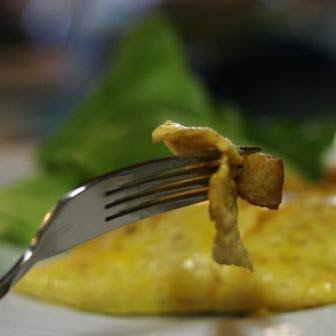 |
| What an egg-citing omelette! |
We had a magically multiplying turkey this Christmas. It fed 19 people and there was still some left. It made sandwiches and delicious turkey soup and there was still some left. Great slices of it were wrapped and given away and there was still some left. Much as I love turkey, there comes a point when it’s enough already!
After all the rich food of Christmas, anyone who makes me the simple treat of a fried egg sandwich gets huge brownie points. It must be on squishy white bread – and lightly cooked so that, when cut, the yolk oozes out and soaks into the bread – sigh…
Another unsophisticated egg/bread combination that I love is this omelette stuffed with croutons. Plain or cheesy, I love both versions.
For an omelette to feed one, you will need…
Croutons
1 slice bread, crusts removed, cut into 1cm cubes
25g butter, melted
For the cheesy version, you’ll need
25g Gruyere, grated or 25g blue cheese, crumbled
¼ teaspoon fresh thyme
Preheat the oven to 160˚C
1. To make the croutons, toss the bread cubes in the melted butter. If making the cheesy version, add the cheese and thyme, turning the bread cubes until coated in the mixture. Spread the cubes out on a shallow baking tray and bake in the preheated oven until golden – about 10 minutes. Turn the oven down to 80˚C to keep them warm while you make the omelette.
Omelette
2 fresh eggs
a pinch of salt
freshly ground black pepper
25g butter
Have a warm plate ready as the omelette takes only a minute to cook and it’s a major culinary sin to put an omelette onto a cold plate.
2. Melt the butter in a small frying pan over a medium/high heat.
3. While the butter is melting, break the eggs into a bowl, add a little salt and pepper, and whisk lightly with a fork until the yolk is just combined with the white of the egg.
4. When the butter is melted and the pan is hot, pour in the egg mixture and let it spread across the base of the pan. Shake the pan back and forth over the heat so that the egg doesn’t stick and burn. When the egg has mostly set and the surface of the omelette is creamy, sprinkle the hot croutons down the centre of the omelette in a line covering roughly about 1/3 of the surface.
5. Using a spatula or fish slice, gently fold 1/3 of the omelette over the croutons, as if you were starting to fold a letter. Then tilt the pan so that the unfolded portion of the omelette slides onto the heated plate. Gently roll the rest of the omelette head-over-heels onto the plate to cover the unfolded portion, enclosing the filling completely.
 |
| Unashamedly unsophisticated (but utterly delicious!) |
Eat immediately with a green salad while you wonder what to do with the rest of the never-ending turkey.
 |
| Mmmmmmmmmmm! |
Speaking of which, any turkey tips?
Pin It












